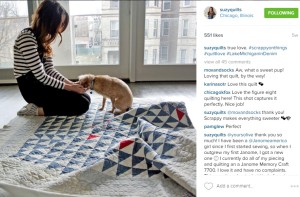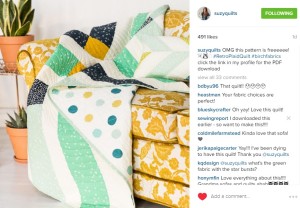Sewing Report catches up with one of the quilters featured in the Quiltonomics article, and she’s made significant changes to her business model.
When I first started emailing with Suzy Williams, I was researching my first “real” quilting article and in search of someone who was selling quilts. Not one of the Etsy sellers peddling them for $75, but someone who was pricing them to more accurately reflect the time and effort put into each one.
Somehow, I found myself at SuzyQuilts.com. Elegant, modern quilts filled the home page. Her prices for baby quilts started at $200 for made-to-order, with custom orders going for $325+.
This was someone who understood the monetary value of a quilt.
“After struggling for about a year to find the balance of what people will pay and what a quilt is worth, I decided to offer two different kinds of quilts,” Williams shared at the time . “Custom or a set pattern with limited color options. I feel like my prices are fair, and the longer I make and sell quilts, the more my audience has adjusted their price expectations.”
Williams has been quilting for over 15 years with a background as a graphic designer. That explains why her website, photography, and graphic elements look so effortlessly put together.
Every quilter shares common ground – it’s like being part of a secret underground society. If you don’t quilt, you won’t understand it.
“When I tell people I quilt, immediately their eyes glaze over,” Williams describes. “They don’t even hesitate – they immediately kind of stare off into space.”
Then there’s the inevitable…
“The comment I love is, ‘Yeah, I think my grandma did that,’” she recounts. “I just want to say, it’s not so much just old patchwork of your grandpa’s jeans and your uncle Bob’s flannel shirt being made into a quilt. This is textile design! These are works of art. These are murals that are mobile. These are beautiful things that creative geniuses are creating today.”

To better describe it to people unfamiliar with quilting, Williams says she introduces two words: textile design. She feels it elevates the art form in the eyes of others.
The spunky, ombre brunette has garnered an impressive following on Instagram @suzyquilts. One of the top nine posts under #quilting is usually one of Williams’ photos.
“I am always so flattered and surprised when people reach out to me and say sweet, encouraging things,” she gushes. “You know, an encouraging word goes such a long way. Even if you see I have X amount of Instagram followers, it’s still a vulnerable place to be. To create something and throw it out there into the universe and hope to God nobody hates it. That’s what’s so beautiful about this quilting community – it’s just really, really kind people building each other up. Elevating each other. Inspiring each other. It is the most wonderful community I’ve ever been a part of.”
Even though Williams was profiled in the Quiltonomics article as a quilt seller, she says she quickly came to a hard realization about making and selling quilts.
“Not so great, because Pottery Barn also sells quilts for a fraction of the price that I would be selling a quilt, and people don’t always see the difference in what I’m doing and what a big-box company is doing.”
According to Williams, the cost and time invested into each of her quilts makes it impossible to create a sustainable business unless she sells them as pieces of art – and dramatically raises prices to match.
Williams and I started emailing back and forth about a week before QuiltCon West in Pasadena, CA. I’d visited SuzyQuilts.com and noticed quilt patterns for sale, rather than finished quilts. More how-to’s and tutorials on her blog. It appeared she was evolving in her personal brand.
“I made the shift in thinking: ‘Okay, if I want this to be a business, which I really do – I need to produce patterns. I need to produce things for the quilting community that they can use. So I can still be a part of this community I love, but maybe turn my business into something else.’”
We met up at QuiltCon on a Thursday. Though it was the first time meeting, I quickly felt like Williams was an old girlfriend and we were just catching up. Even she didn’t seem to quite grasp her huge popularity online, and there’s an authenticity to her that just can’t be replicated.
When I ask her how she accomplishes such amazing photography, she tells me a secret: Williams uses a digital point-and-shoot camera on the auto setting and boosts the images later using Adobe Photoshop and heightening the brightness and contrast.
She showed me her quilts in the show,(Modern Fans, Drip, and Mod Mountains) as well as the Mod Melons and Retro Plaid quilts she made for Birch Fabrics. (FREE patterns are available here)
 Williams says she’s now turning down custom quilt requests, and in the future – will only sell quilts she has designed herself with fabric she chooses.
Williams says she’s now turning down custom quilt requests, and in the future – will only sell quilts she has designed herself with fabric she chooses.
“This will be a total experiment, so I’m not sure how it’s going to go down,” she wrote in an email.
The ultimate dream for this quilter would be to license or sell her patterns to manufacturers to mass produce her designs, so that perhaps her quilts would be in homes across the country – possibly the world.
“I just want to inject my excitement for quilting into the already vibrant quilting community that’s there,” Williams notes. “I also really get excited about pattern writing. I love sitting at my sewing machine and quilting, but the idea of creating a pattern that other people are going to make and put their own spin on it is really exciting to me.”
Great report and interview!